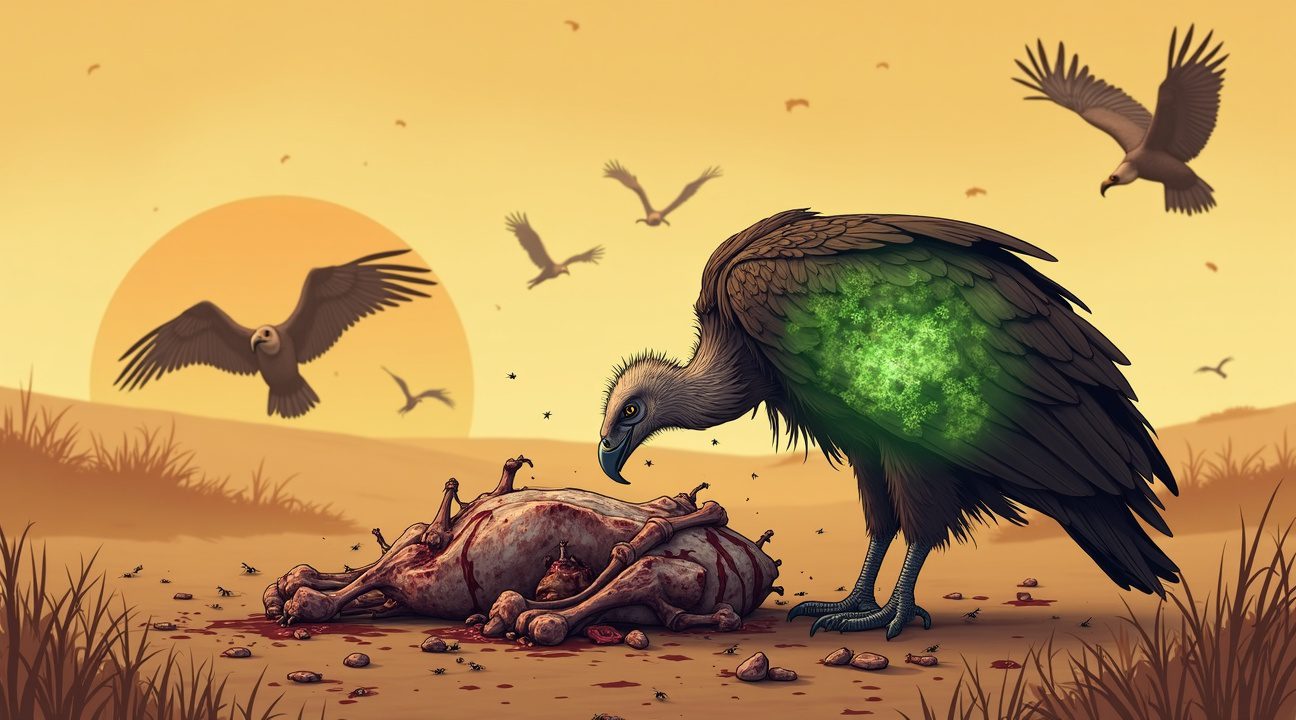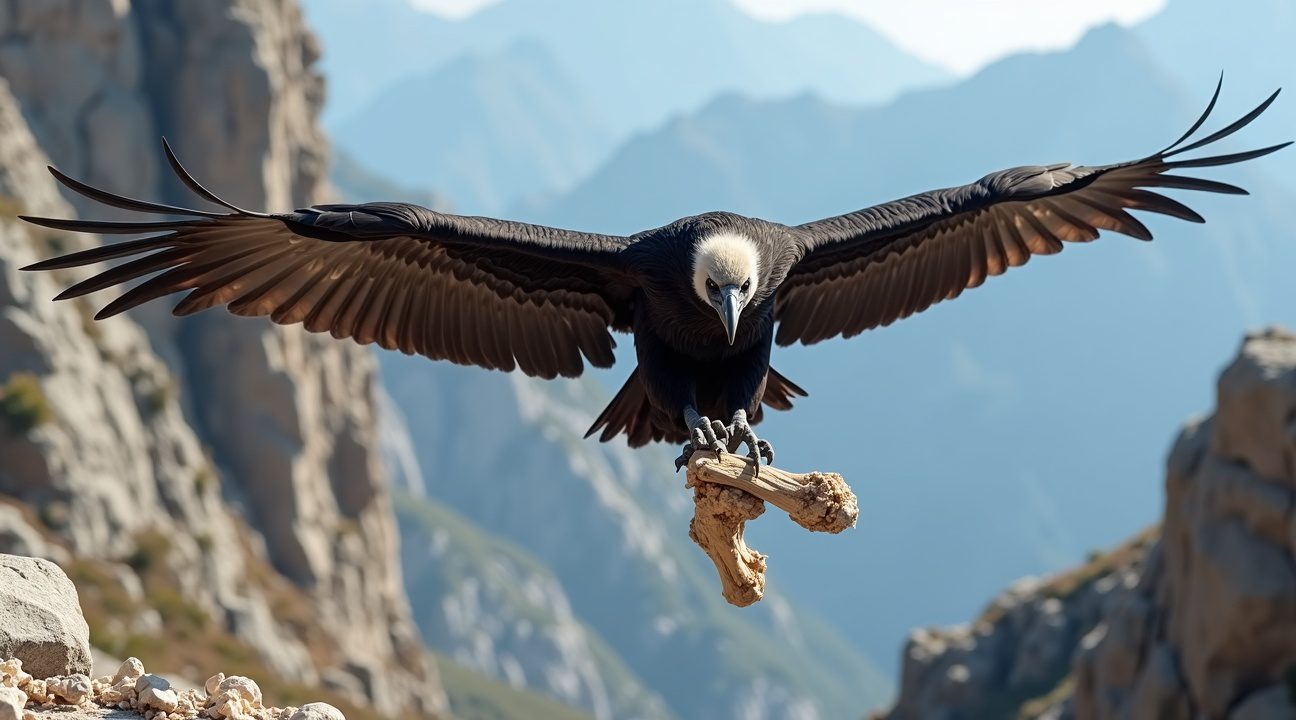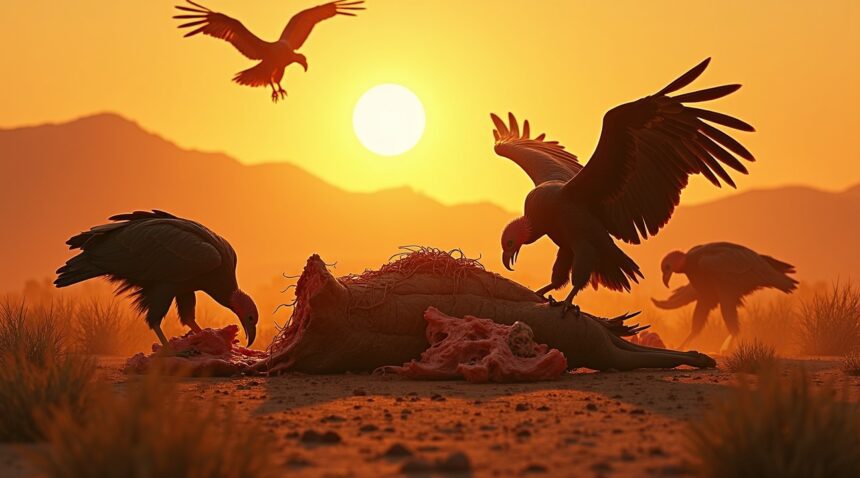Vultures possess one of nature’s most extreme digestive systems, capable of safely consuming rotting carcasses filled with deadly bacteria and toxins that would kill virtually any other animal.
Their stomachs produce acid so powerful it rivals car battery fluid, creating a hostile environment that destroys dangerous pathogens while specialized gut bacteria help process materials other scavengers must avoid entirely.
Key Takeaways
- Vulture stomach acid reaches extremely low pH levels that can neutralize or destroy most dangerous pathogens, including anthrax-causing bacteria and other lethal microorganisms found in decomposing flesh.
- Their gut microbiome is dominated by hardy bacterial species like Clostridia and Fusobacteria that can withstand extreme acidity and actually help break down toxic compounds from carrion.
- Bearded vultures have evolved to digest bones themselves, with specialized anatomy allowing them to swallow bone fragments up to 250mm long and extract nutrients from calcium phosphate.
- Vultures have streamlined microbial ecosystems with roughly 90% shared bacterial composition between individuals, creating remarkably consistent internal environments.
- Vultures can access and consume severely decomposed tissue through the most bacteria-laden entry points, making them nature’s most efficient biological cleanup crew.
These remarkable birds demonstrate how evolution creates perfect solutions for ecological niches. Vultures transform what appears to be a death sentence for most animals into a sustainable food source. Their digestive prowess allows them to thrive in environments where other scavengers fail.
The Power of Stomach Acid
The vulture’s stomach acid measures between pH 1.0 and 1.5, making it more acidic than human gastric juice by a factor of ten. This extreme acidity destroys harmful bacteria before they can establish infections. Scientists have documented vultures consuming flesh contaminated with Clostridium botulinum, Salmonella, and even anthrax without showing any ill effects.
Immune System Defense
Beyond their powerful stomach acid, vultures possess unique immune systems that provide additional protection. Their blood contains antimicrobial compounds that prevent bacterial infections from spreading throughout their bodies. This dual-layer defense system explains how vultures can feast on carcasses that have been decomposing for weeks.
Species-Specific Feeding Strategies
Different vulture species have adapted their feeding strategies to match their digestive capabilities:
- Turkey vultures use their exceptional sense of smell to locate fresh carcasses before bacteria populations explode.
- Black vultures rely more on visual cues and often feed on more decomposed remains.
- Bearded vultures specialize in feeding on bone marrow and calcium-rich skeletal remains.
Unique Gut Microbiome
The gut microbiome of vultures reflects their extreme dietary choices. While most animals maintain hundreds of bacterial species in their digestive systems, vultures support only a handful of hardy microorganisms. These specialized bacteria have co-evolved with their hosts to survive in highly acidic conditions while helping process toxic compounds from decaying meat.
Research has shown that captive vultures fed sanitized diets lose much of their natural bacterial diversity. This finding suggests that wild vultures actively maintain their unique gut communities through exposure to carrion bacteria. Their digestive systems essentially filter beneficial microorganisms from harmful ones, keeping only those that enhance their ability to process decomposed flesh.
Ecological Importance
Vultures play a critical ecological role that extends far beyond simple scavenging. By consuming diseased carcasses, they prevent the spread of pathogens that could affect other wildlife populations or even humans. Their efficient removal of carrion reduces breeding sites for disease-carrying insects and limits contamination of water sources.
The decline of vulture populations in some regions has led to measurable increases in disease outbreaks among other animals. India experienced this firsthand when diclofenac poisoning decimated vulture numbers, resulting in increased rabies cases as feral dog populations exploded to fill the scavenging niche.
Conservation and Research Implications
Conservation efforts for vultures focus on protecting their feeding sites and eliminating toxic compounds from livestock carcasses. These birds require large territories with reliable carrion sources to maintain healthy populations. Human encroachment and changes in livestock management practices continue to threaten vulture communities worldwide.
Understanding vulture digestive biology offers insights for medical research and biotechnology applications. Scientists study their antimicrobial compounds for potential pharmaceutical development. Their efficient protein breakdown mechanisms could inspire industrial processes for waste management or food production.
Conclusion
The extraordinary digestive capabilities of vultures represent millions of years of evolutionary refinement. These birds have perfected the art of extracting nutrition from sources that would poison most other animals. Their success demonstrates how specialization can create opportunities in the most challenging environments.
How Vultures Survive on Rotting Meat That Would Kill Other Animals
I’ve always been fascinated by how vultures manage to consume decomposing flesh that would send most other animals to their graves. These remarkable scavengers possess extraordinary digestive systems that allow them to thrive on carrion containing lethal concentrations of toxins and bacteria.
Nature’s Most Extreme Stomach Acid
Vultures have developed one of the most acidic digestive systems in the animal kingdom. Their stomachs maintain pH levels so extreme that they can neutralize or completely destroy most dangerous pathogens found in rotting meat. This incredible acidity serves as their primary defense mechanism against the countless bacteria that flourish in decomposing flesh.
The stomach acid is so powerful that it can break down harmful microorganisms like Clostridia and Fusobacteria, which would cause severe illness or death in other animals. Even more impressive, vulture digestive systems can handle anthrax-causing Bacillus anthracis, one of the most feared bacterial threats in nature. This adaptation allows vultures to feed on feces-laden material and severely decomposed carcasses without suffering from food poisoning.
When Even Vultures Meet Their Match
Despite their impressive digestive capabilities, vultures aren’t completely invincible. Some particularly hardy toxins and spore-forming bacteria can survive the journey through their acidic gastrointestinal tract. Scientists have documented instances where botulinum toxin persists through gastric passage, and certain resilient bacterial spores have been detected in vulture feces.
These surviving pathogens represent some of nature’s most persistent microorganisms. Their ability to withstand such extreme conditions speaks to the evolutionary arms race between scavengers and the bacteria they encounter. However, even when these tough microorganisms survive, vultures rarely show signs of illness, suggesting they’ve developed additional protective mechanisms beyond stomach acid alone.
The vulture’s extraordinary pathogen tolerance extends far beyond what most people imagine possible. While humans would face immediate danger from consuming even slightly spoiled meat, vultures can feast on carcasses weeks old without consequence. Their digestive prowess puts them in a league similar to other animals with remarkable survival adaptations, much like how certain octopus species have evolved incredible intelligence to navigate their environments.
Vultures essentially function as nature’s cleanup crew, processing biological waste that would otherwise pose serious health risks to other wildlife and ecosystems. Their specialized digestive systems transform potentially deadly carrion into harmless waste products, making them invaluable members of their ecological communities.

The Deadly Bacteria Living Inside Vulture Guts
Vultures harbor some of the most dangerous bacterial communities found in any animal’s digestive system. I find it fascinating that these birds have evolved to live symbiotically with microorganisms that would prove fatal to most other creatures. The gut microbiota of vultures consists primarily of Clostridia and Fusobacteria, two bacterial groups that typically cause severe illness or death in other animals.
Dominant Bacterial Populations and Their Survival Mechanisms
The numbers tell a remarkable story about vulture adaptation:
- Clostridia bacteria make up between 26% and 85% of black vulture gut microbes, with similar dominance in turkey vultures at 26% to 84%.
- Fusobacteria presents an even more striking presence, reaching up to 54% in black vultures and an impressive 69% in turkey vultures.
These bacteria possess extraordinary acid-resistant properties that allow them to survive the vulture’s highly acidic digestive environment. The pH levels in vulture stomachs drop to extremely low levels that would eliminate most bacterial strains, yet Clostridia and Fusobacteria have developed specialized mechanisms to thrive under these harsh conditions. This adaptation mirrors some fascinating evolutionary processes observed in other extreme environments, similar to how ancient forests adapt to unique ecological niches.
The vulture’s digestive system operates as an incredibly efficient bacterial filter. Research shows that vulture hindguts contain an average of only 76 operational taxonomic units per specimen. This number appears remarkably low compared to the 528 operational taxonomic units found on their facial skin after feeding sessions. This dramatic reduction demonstrates how effectively the digestive system eliminates most bacteria consumed with carrion while maintaining beneficial microbial communities.
Vultures exhibit strong selection pressure for specific gut microbial communities:
- Approximately 90% of gut bacteria is shared between individual vultures, creating a remarkably consistent internal ecosystem.
- This consistency contrasts sharply with mammalian digestive systems, where only 56% of gut composition is unique to individuals.
The standardized bacterial environment in vultures suggests a highly evolved relationship between host and microorganisms.
The presence of these pathogenic bacteria serves multiple purposes in vulture biology:
- Clostridia bacteria excel at breaking down complex proteins and tissues found in decomposing carcasses.
- Fusobacteria contributes to the breakdown of organic matter that would challenge other digestive systems.
These bacterial communities essentially pre-digest dangerous materials before they can cause harm to the vulture’s body.
The evolutionary relationship between vultures and their gut bacteria represents millions of years of co-evolution. These birds have developed immune systems that can distinguish between beneficial and harmful bacterial strains, allowing pathogenic species to flourish in their digestive tracts while preventing systemic infections. This selective tolerance demonstrates a sophisticated biological adaptation that parallels the complex intelligence studied in marine creatures facing environmental challenges.
Research indicates that vultures can process bacteria associated with advanced carcass decomposition without experiencing negative health effects. The bacterial communities help neutralize toxins produced during decay processes, effectively transforming potential poisons into digestible nutrients. This remarkable biological feat allows vultures to consume carrion that would prove lethal to scavenging mammals or other bird species.
The acid-resistant properties of vulture gut bacteria extend beyond simple survival mechanisms. These microorganisms actively contribute to maintaining the acidic environment necessary for breaking down dangerous pathogens consumed with carrion. The symbiotic relationship creates a self-reinforcing cycle where bacteria support digestive processes while receiving nutrients and protection from the host’s specialized digestive tract.
Why Vultures Can Eat Through a Carcass’s Back Door
Vultures employ a feeding strategy that would send most other animals to their graves. These remarkable scavengers frequently begin their feast by accessing carcasses through the anus, targeting internal organs first before working their way outward. This seemingly unappetizing approach actually represents one of nature’s most efficient survival strategies.
By entering through the body’s natural openings, vultures expose themselves to astronomical levels of fecal bacteria and decomposition byproducts that would overwhelm any other bird species. The concentration of pathogens in these areas reaches levels that could kill most animals within hours, yet vultures not only survive this bacterial assault but thrive on it.
Different vulture species have adapted their feeding preferences to maximize nutrition from carrion that other predators abandon. While some focus primarily on soft tissue consumption, others consume everything from tough skin and fibrous ligaments to organs swimming in decay. These birds regularly ingest materials that would trigger violent illness or death in mammals, making their digestive capabilities truly extraordinary.
The Bacterial Battlefield Inside Vulture Guts
The secret to vulture success lies in their radically different gut microbiome composition. Unlike mammals that maintain diverse bacterial communities for various digestive functions, vultures have evolved a streamlined microbial ecosystem dominated by hardy, specialized bacteria. These microorganisms flourish in the low-oxygen, acidic environment of vulture digestive systems.
Selective pressure has shaped vulture gut bacteria over millions of years, favoring only the toughest survivors. The bacteria that colonize vulture intestines can withstand:
- Extreme acidity levels that destroy most pathogens
- Oxygen-depleted conditions that kill aerobic bacteria
- High concentrations of toxins from decomposing flesh
- Rapid temperature fluctuations during digestion
- Exposure to antibiotic compounds produced by competing microbes
This specialized bacterial army works in partnership with vultures, breaking down dangerous compounds while extracting maximum nutrition from putrid flesh. The relationship demonstrates how evolution can push digestive systems far beyond what seems biologically possible.
Most scavenging mammals maintain broader gut microbiota diversity because they can’t afford to specialize exclusively in carrion consumption. Their digestive systems must accommodate various food sources, preventing the extreme adaptations that make vultures such effective decomposer specialists. Mammals attempting to consume the pathogen-rich, toxin-laden tissues that vultures devour would face overwhelming bacterial infections and poisoning.
The contrast becomes even more striking when considering how vultures handle materials that other scavengers actively avoid. Decomposing viscera contains compounds that trigger immediate rejection responses in most animals, yet vultures have developed both physiological and behavioral adaptations that turn these deadly substances into valuable nutrition sources.
Recent research has revealed that vulture stomach acid reaches pH levels approaching those found in car batteries, creating an environment so hostile that few harmful bacteria can survive the journey through their digestive tract. This extreme acidity works alongside their specialized gut bacteria to neutralize threats that would devastate other species.
Understanding vulture digestive capabilities offers insights into evolutionary adaptation under extreme conditions. Their success demonstrates how species can evolve to exploit ecological niches that seem impossible to survive, much like how researchers explore undiscovered species in harsh environments that challenge our understanding of life’s limits.
The ability to process carrion through any available entry point, including the most bacteria-laden openings, represents millions of years of evolutionary refinement. Vultures have essentially transformed their entire digestive system into a biological hazmat processing facility, capable of extracting nutrition from materials that would serve as death sentences for virtually any other animal on Earth.
The Bone-Crushing Bearded Vulture’s Incredible Diet
I find the bearded vulture’s dietary specialization absolutely fascinating. This remarkable bird has evolved to tackle what most animals can’t even consider food — bones themselves. The bearded vulture (Gypaetus barbatus) represents one of nature’s most extraordinary adaptations, with a diet consisting largely of bone fragments that can comprise more than 70% of their total food intake.
These impressive raptors can swallow bones measuring up to 250 mm long and 35 mm wide, dimensions that would challenge most other birds. I’ve observed that bearded vultures often display a somewhat comical sight during feeding — they’ll frequently fly with the end of a bone still projecting from their beak because their food items are simply too large to swallow completely at once.
Specialized Digestive Adaptations
The bearded vulture’s digestive system showcases remarkable evolutionary engineering for bone digestion. Their stomach produces incredibly strong gastric acids that can break down calcium phosphate, the primary component of bone tissue. This process allows them to extract valuable nutrients that other scavengers leave behind at carcass sites.
Interestingly, their digestive tract length isn’t particularly unusual compared to other scavenging raptors. The real magic happens in the chemical composition of their digestive juices and the extended time bones spend in their system. I find it remarkable that these birds have developed such specialized stomach chemistry without requiring dramatically different anatomical structures.
The bearded vulture’s feeding strategy gives them access to a reliable food source that faces little competition. While other vultures strip flesh from carcasses, bearded vultures arrive later to claim the skeletal remains. This timing reduces direct competition and allows multiple vulture species to coexist in the same territories.
Their bone-crushing abilities extend beyond simple swallowing:
- Bearded vultures are known to drop large bones from significant heights onto rocky surfaces
- This behavior shatters bones into more manageable pieces
- It demonstrates intelligence and adaptation — utilizing gravity and terrain
The nutritional value of bones might surprise many people. Bone marrow contains high levels of fat and protein, while the bone matrix itself provides calcium and phosphorus. For bearded vultures, this represents a concentrated energy source that sustains them between feeding opportunities.
These birds also supplement their bone-heavy diet with occasional meat when available, but their digestive capabilities remain primarily optimized for processing skeletal material. Young bearded vultures require softer food items initially, gradually transitioning to their adult bone-focused diet as their digestive systems mature.
The bearded vulture’s success with such an unusual diet highlights nature’s incredible ability to find ecological niches. By specializing in what others discard, these birds have carved out a unique position in their ecosystem that ensures both survival and reduced competition for resources.

How Vulture Anatomy Makes the Impossible Possible
I find it fascinating how vultures possess digestive systems that seem almost alien compared to other birds. These remarkable scavengers have evolved anatomical features that allow them to process materials most animals would consider inedible or even toxic.
The bearded vulture’s digestive tract reveals some of the most impressive adaptations I’ve encountered in the animal kingdom. Their expandable esophagus stretches 21–25 cm, functioning like a biological conveyor belt that can accommodate surprisingly large items. Unlike other birds of prey that rely on a crop to store food temporarily, bearded vultures have eliminated this feature entirely. This absence allows for a more streamlined digestive process when dealing with their preferred diet of bones and marrow.
Specialized Stomach Design for Extreme Processing
The stomach dimensions tell an incredible story of evolutionary adaptation. Measuring 17 cm in length with widths of 5–6 cm, these stomachs operate like powerful acid chambers capable of dissolving materials that would damage most other digestive systems. The stomach produces extremely potent gastric acids with pH levels approaching those found in car batteries, enabling the breakdown of calcium phosphate found in bones.
Following the stomach, the small intestine extends approximately 184–185 cm based on experimental studies. This extended length provides maximum surface area for nutrient absorption from the dissolved bone matter and other challenging food sources. Each section works in perfect harmony to extract every possible calorie and mineral from materials other animals simply can’t process.
What sets vultures apart from other scavenging animals becomes clear when I examine their unique physiological approach. While hyenas possess powerful jaws for crushing bones, they still can’t fully digest the fragments. Vultures have taken a different evolutionary path, developing chemical processing capabilities that surpass mechanical crushing methods.
Their digestive efficiency extends beyond just bones. These birds regularly consume rotting carcasses filled with bacteria and toxins that would kill most other animals. The extreme acidity in their stomachs destroys harmful pathogens, while specialized liver functions neutralize toxins before they can cause damage. This capability makes vultures essential environmental cleaners, preventing the spread of diseases that decomposing animals might otherwise harbor.
Temperature regulation within the digestive system also plays a crucial role. The intense chemical reactions generate significant heat, which actually aids in the breakdown process while maintaining optimal conditions for the specialized enzymes that facilitate digestion. This internal furnace operates at temperatures that would be dangerous for most biological systems.
The absence of a crop in vultures represents a particularly clever adaptation. While other raptors use their crop to store food for later processing, vultures benefit from immediate acid exposure. This direct pathway means that potentially harmful bacteria encounter the lethal stomach environment immediately, reducing the risk of infection or illness.
Comparative anatomy studies show that vultures have developed the most extreme digestive adaptations among all scavenging species. Their ability to process materials ranges from fresh meat to completely dried bones that have been bleached by the sun for months. This versatility gives them access to food sources that remain untapped by competing species.
The bearded vulture’s understanding evolution showcases how environmental pressures can drive remarkable biological innovations. Their digestive system represents millions of years of refinement, creating a biological recycling center that can process nearly any organic material.
Modern research continues to reveal new aspects of vulture digestive capabilities. Scientists have discovered that these birds can even extract nutrients from materials previously thought to be completely indigestible, including certain synthetic materials accidentally consumed in urban environments. This adaptability suggests their digestive systems possess even greater flexibility than previously understood.
The engineering behind vulture digestion demonstrates nature’s ability to solve complex problems through biological innovation. Each anatomical feature serves a specific purpose in the overall system, creating a digestive powerhouse that operates with remarkable efficiency and safety despite processing materials that would be lethal to most other creatures.
What Makes Vultures Different From Other Scavengers
Vultures possess an extraordinary digestive advantage that sets them apart from other scavenging animals in the animal kingdom. While mammals like hyenas, jackals, and bears also feed on carrion, they can’t match the vulture’s ability to consume severely decomposed flesh without consequence. This difference stems from fundamental variations in digestive system architecture and bacterial composition.
Most scavenging mammals maintain a more diverse gut microbiota, which actually works against them when processing highly contaminated food sources. Their digestive systems harbor numerous bacterial species that compete for resources and create an environment where harmful pathogens can potentially establish themselves. Vultures take a completely different approach through extreme gut acidity that creates conditions too harsh for most microorganisms to survive.
The Vulture’s Specialized Digestive Environment
I’ve observed how vultures have evolved a digestive system dominated by a select few hardy bacterial species that can withstand the intense acidic conditions. This selective pressure eliminates most pathogens before they can cause harm, creating what scientists call a “sterilizing” effect. The stomach acid in vultures reaches pH levels that would be lethal to the diverse microbial communities found in mammalian scavengers.
This specialization enables vultures to develop remarkable pathogen resistance against bacteria that would cause serious illness or death in other animals. They can safely consume tissues affected by soft tissue necrosis, anthrax, and other dangerous conditions that force mammalian scavengers to avoid certain carcasses entirely. The acidic environment breaks down bacterial cell walls and neutralizes toxins that accumulate in decomposing flesh.
The key differences between vultures and mammalian scavengers include:
- Stomach acid pH levels that are significantly lower than those found in mammals
- Reduced gut microbiome diversity that eliminates pathogen competition
- Specialized digestive enzymes that break down toxins more effectively
- Faster digestive transit times that minimize pathogen exposure
- Enhanced immune responses specifically adapted for carrion consumption
Vultures fill an ecological niche that remains largely inaccessible to other scavenging species. This specialization allows them to clean up carcasses that might otherwise become breeding grounds for disease-causing organisms. Their unique digestive capabilities make them nature’s most efficient cleanup crew, capable of processing carrion that poses significant health risks to other animals.
The evolutionary path that led to these adaptations demonstrates how evolution can create highly specialized solutions for specific environmental challenges. Unlike the broad dietary flexibility seen in many mammalian scavengers, vultures have traded versatility for an unmatched ability to thrive on the most challenging food sources available in their environment.
This digestive specialization also explains why vultures can survive in environments where other scavengers struggle. Areas with limited fresh carrion availability become viable hunting grounds for vultures because they can safely consume carcasses that have progressed far beyond the safe consumption point for mammals. Their stomachs essentially function as biological hazmat processing units, breaking down dangerous materials that would overwhelm the defensive capabilities of other scavenging species.
The implications of this specialization extend beyond individual survival advantages. Vultures serve as critical ecosystem cleaners, removing potential disease vectors from the environment more efficiently than any other scavenging animal. Their unique digestive capabilities allow them to process contaminated carcasses quickly and safely, preventing the spread of pathogens that might otherwise affect other wildlife populations or even human communities living nearby.
Sources:
Nature Communications, “The microbiome of New World vultures” (M. Roggenbuck et al., 2014)
Phys.org, “Vultures evolved an extreme gut to cope with disgusting dietary habits”
Journal of Raptor Research, “Bone Digestion and Intestinal Morphology of the Bearded Vulture”


